English Style Scones
These English Style Scones bake up light, soft, and fluffy, and are a wonderful treat for breakfast or afternoon tea. Spread them with jam, clotted cream, butter, or simply eat them plain. They’re incredibly delicious and are made in 25 minutes. No chilling required!
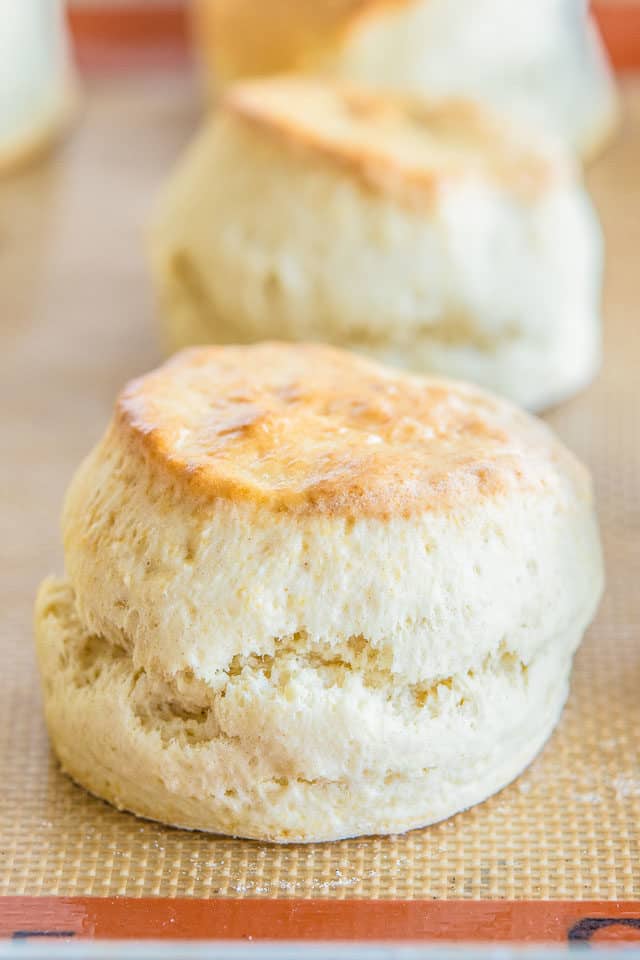
To this day, if you go to my childhood home and open up the refrigerator, you will find bags of scones in there, made by a bakery called Sconehenge. Located in Berkeley, California, I devoured these absurdly delicious scones all throughout my childhood.
My dad still has access to these scones since he lives in the Bay Area, but it has been 15 years since I lived in California. Translation: my enjoyment of these scones, the best scones (!), has been limited to brief Christmas and summer visits.
I remember a few years ago I tried to recreate these scones, and searched the internet endlessly with phrases like “Sconehenge recipe,” “Sconehenge copycat recipe” and “how to make Sconehenge scones.” Nothing came up. It made me crazy!!! I couldn’t figure out how these scones were so different from American scones like Maple Scones and Cheddar Chive Scones. These tender scones weren’t hard or dry. Rather, they were soft, fluffy, pillows of wonder.
The mystery was finally solved when I went to England and tasted an English Style Scone. I took one bite and thought, THIS TASTES LIKE SCONEHENGE! Then the “duh” moments poured in. Sconehenge…a riff on Stonehenge…which is in England…oh. The things you realize AFTER the dots have been connected.
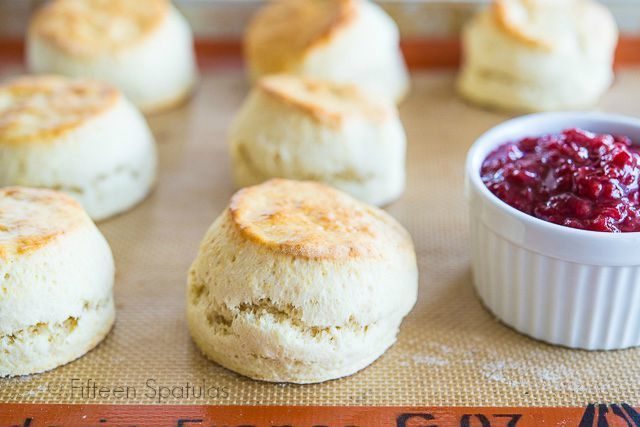
Well, the good news is now I know how to make these delightful scones. They’re English style!
English scones are made differently from American scones, and instead of being stiff and dry, they’re fluffy and soft. A lot of people think these look like American biscuits, and they kind of do, but they’re prepared quite differently.
Tips for Best Results
Work quickly, and resist the urge to add excess flour – I paired these two tips together, because they really go hand in hand. You’ll want to have all your ingredients ready to go so that you can carry the recipe out quickly, because the butter will only get warmer and the dough stickier if you take too long.
Push the cutter straight down – When you go to cut your circles of scone dough, make sure to push the cutter straight down. Do not twist the cutter. This will ensure the scones rise as high as possible.
Use the best quality butter – It’s incredible how different brands make wildly different tasting butters. Some don’t taste like much of anything, while others have incredibly rich flavor, that slightly sweet dairy fat flavor all humans love. My favorite butter is Kerrygold. Plugra and Vermont Creamery also make great butter. If you look up butter taste tests online, you’ll see that they are definitely not all equal.
Step by Step Overview:
To get started, combine all-purpose flour, salt, baking powder, and sugar in a food processor, then add softened butter:
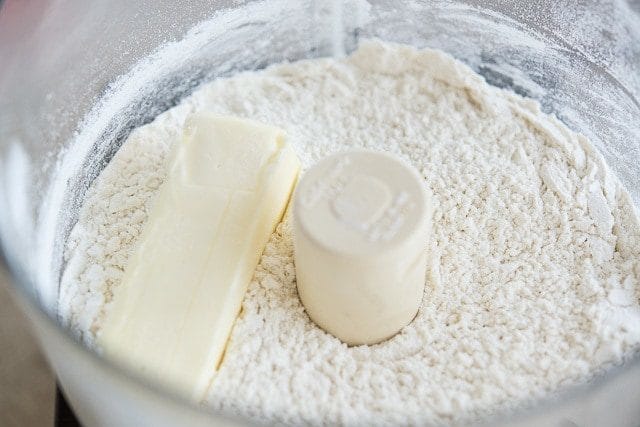
Why not cold butter?
Using softened or room-temperature butter instead of cold butter is one of the major differences between English style scones and both biscuits and American-style scones. Biscuits and American scones both use cold butter that’s rubbed or “cut” into the dry ingredients, and left in chunks. Here we want more of a sandy texture.
Pulse the food processor ingredients until the softened butter is well incorporated into the flour.
Note: If you don’t have a food processor and are using a pastry cutter, you’ll need to work it through quite a bit to get the texture right.
You can see that unlike a pie crust, we don’t have big pieces of butter in the flour. Rather, it has a sandy, soft texture:
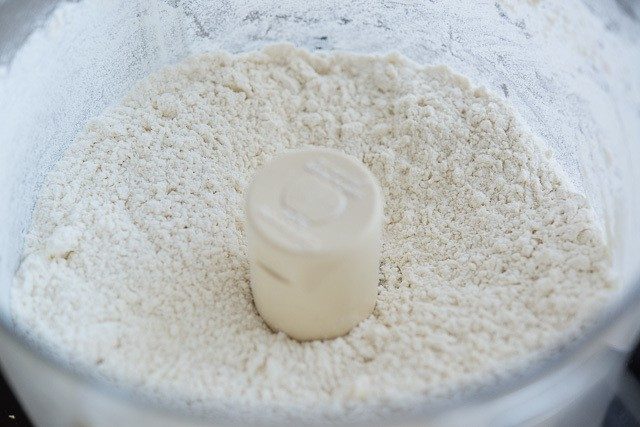
Dump this mixture into a large bowl.
Whisk together milk and an egg, saving 2 tablespoons of this egg wash in a small bowl for later. Then add the rest to the flour mixture:
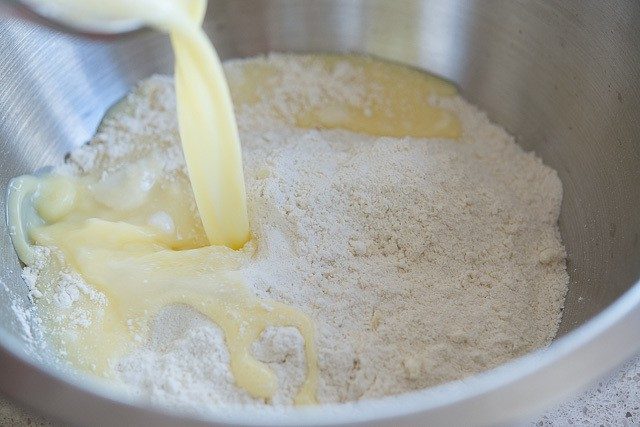
Stir together with a spatula, then when it’s roughly combined, dump it onto a lightly floured surface:
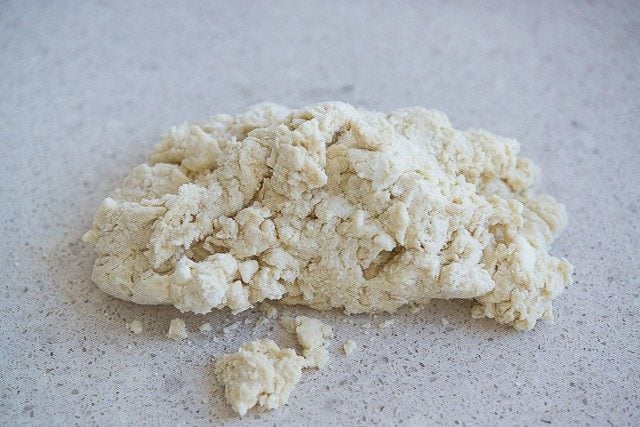
The mixture will be wet, but resist the urge to add too much excess flour, since this will make your English scones drier.
Lightly flour the dough, then knead it until it smooths out a bit, just a few times:
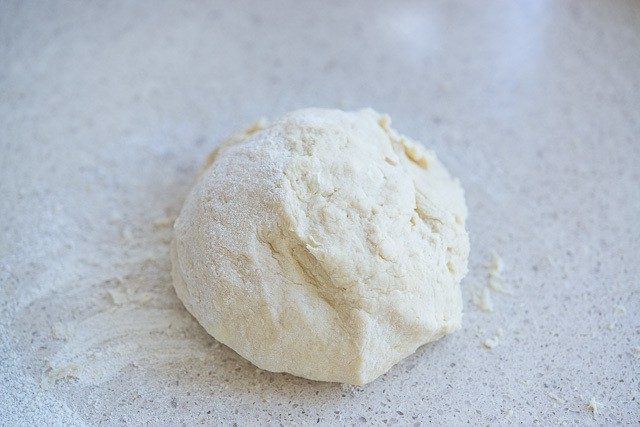
You can see that it’s still sticky, and there are bits sticking to my counter. Again, this is important for a hydrated dough, a soft texture, and good rise.
As with anything where you combine flour with liquid, try not to knead too much, or excess gluten will develop and make the scones tough, and also prevent them from rising as high.
Roll the dough about an inch thick:
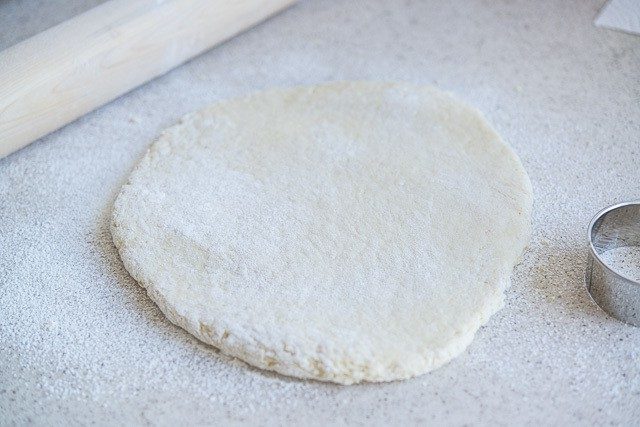
Use a 2.5″ cutter to cut circles, or, use a sharp knife to cut square pieces. Then place them on a silicone mat or parchment paper lined baking sheet.
Make sure not to twist the cutter at all when cutting the circles. Push straight down toward your work surface, otherwise they won’t rise as tall.
How to freeze these, if you’d like:
At this point you may freeze the unbaked scone circles, then when you’re ready to eat, bake them from frozen at the same temperature for about 5 extra minutes.
You can also freeze completely baked scones, and let them thaw to room temperature when you’d like to eat them. Bread and baked goods tend to freeze beautifully.
Before baking, brush each scone circle with the reserved egg milk wash:
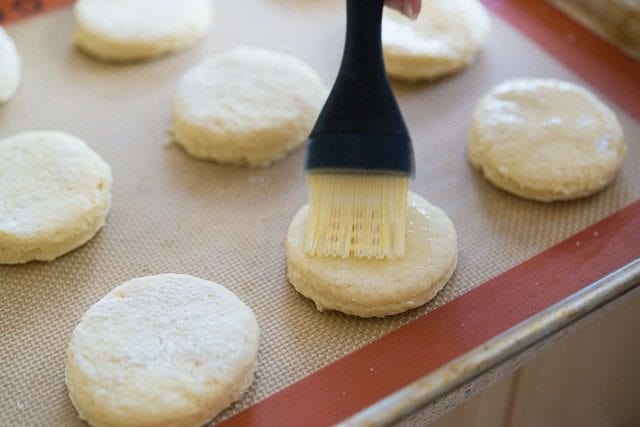
After a quick trip into a hot oven, about 15 minutes, they’ll be puffed and golden brown, with a slightly crisp exterior:
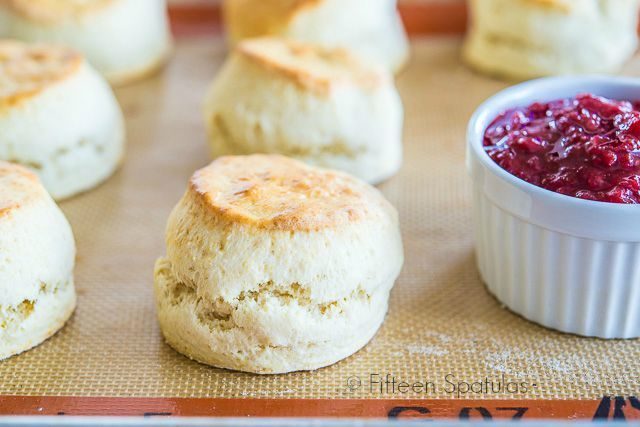
I like to enjoy them fresh and warm from the oven, but if you plan to store leftovers, make sure to cool completely on a wire rack before storing in an airtight container.
How to Serve
Serve the scones while they’re warm with your favorite jam (I love this strawberry jam) and clotted heavy cream for extra bonus points. My grocery store sells this in the fancy cheese section. Butter is of course lovely too, especially Homemade Orange Honey Butter.
You can certainly enjoy these after they’ve cooled as well, but like many baked goods, they are always at their peak when they’re fresh and warm out of the oven. I love these for Mother’s day, baby showers, and weekend brunches.
For your next homemade baking projects, I also suggest these Homemade English Muffins, my favorite Banana Bread, and Pumpkin Muffins.
Flavor Additions and Substitutions
Here are a few easy ways to experiment with different flavor combinations. This is a great recipe for playing around with variations, and can be looked at as a master scone recipe of sorts.
Citrus zest: If you’d like to add orange zest or lemon zest, those additions work beautifully. Add up to 1 tablespoon of zest to the flour mixture.
Dried fruits: Add up to 1 cup of your favorite dried fruit after you’ve combined the wet and dry ingredients, but before all the flour has moistened. Blueberry scones made with dried blueberries are one of my favorites. Dried cherries are also wonderful.
Crunchy sugar: For an exterior crunch, sprinkle on a little sugar to the tops of each scone after brushing with egg wash. Turbinado sugar has great texture.
Chocolate chips: Add up to 1 cup of your favorite chocolate chips after you’ve combined the wet and dry ingredients, but before all the flour has moistened.
What about fresh fruit? This is possible, but I issue a caution. Add up to 1 cup, but know that fresh fruits are trickier because they tend to be wet, and this is already a fairly wet dough. Adding fresh fruit makes the scone dough more challenging to work with.
Recipe Tips and FAQ
At room temperature, for a few days. In the fridge, for a couple weeks. In the freezer, a few months. Because there are only simple ingredients here and no preservatives, the scones will mold if left out for more than a few days.
You can either freeze scones baked or unbaked. To freeze baked scones, let them cool to room temperature, then freeze in an airtight bag for up to 3 months. To freeze unbaked scones, make the recipe up to cutting the dough circles, then bake the circles straight from frozen for 5 extra minutes, or until cooked through.
Bake in a 300F oven for 5-10 minutes, until warmed through. You can also cut them in half and toast them. Add a few extra minutes if reheating from frozen.
Yes. Like any baked good, these are best fresh, but they’re still fantastic the next day. Reheat them per the instructions above, or bake from frozen (instructions are in the post).
As noted above, it’s normal for the dough to be a little bit sticky, but it should still be workable. If it’s not workable, this is probably either because there’s not enough flour, or the butter got too warm. So first, try to weigh the flour if possible. There is already so much variation between cup measuring and brands, and weighing the flour will help ensure proper proportions. Next, try to assess if the dough needs more flour, or if it’s too warm. For example, if the butter you used is softened above 70 degrees F (or if you used the microwave softening feature for a bit too long), the butter may be too warm by the time you’re working with it. Popping the dough into the fridge will firm the butter slightly, and may help you roll it out. Or, you can add just enough flour to the outside to roll it out, then cut the pieces.
First, make sure you’re using fresh baking powder, one that has been opened less than 6 months ago. Also, if you knead the dough too much, the scones won’t rise as tall. Knead gently, and just enough to bring the dough together. Adding more flour also prevents the dough from rising as high, so only dust lightly.
Did you enjoy the recipe? Please leave a 5-star rating in the recipe card below and/or a review in the comments section further down the page. Or, follow me on Facebook, Instagram or Pinterest!
Here’s a video I made for the scones, if you’d like some more visuals on the process:
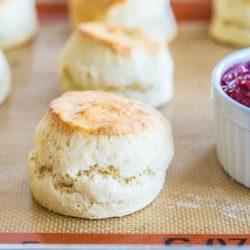
English Style Scones
Ingredients
For the Scones:
- 2 cups all-purpose flour (10 ounces by weight)
- 4 tsp baking powder
- 1/2 tsp salt
- 1/4 cup sugar
- 6 tbsp unsalted butter at room temperature
- 2/3 cup whole milk
- 1 large egg
Instructions
- Preheat the oven to 425 degrees F.
- In a food processor, pulse the flour, baking powder, salt, and sugar a couple times to combine.
- Add the butter and pulse 7-10 times until the butter is completely distributed. You shouldn’t see any chunks of butter, and the mixture should have a sandy texture to it. Transfer to a large mixing bowl.
- In a small bowl, whisk to combine the milk and egg. Save 2 tbsp of it for the egg wash later, and pour the rest into the mixing bowl with the dry ingredients.
- Stir to combine with a spatula, until a rough dough forms.
- Transfer to a lightly floured countertop and knead about 10 times until the dough comes together into a relatively smooth ball. Take care not to knead too much, or the dough will be tougher and not rise as high.
- Roll the dough about an inch thick and use a 2.5″ cutter to cut about 7 circles. Re-roll the scraps and cut out another 2.
- Place the scones onto a parchment or silicone mat lined baking sheet and brush the tops with the reserved egg wash.
- Bake the scones for 13-15 minutes, until about tripled in height, and golden brown on the tops and bottoms. Enjoy!
Notes
Nutrition
Nutrition is estimated using a food database and is only intended to be used as a guideline for informational purposes.

549 Comments on “English Style Scones”
Hi , I don’t have a food processor ,
How else can I mix the dry ingredients with the flour . These look so yummy I can’t wait to make them
Thanks
Hi Dee, since the butter is soft/at room temperature, you could use a hand mixer instead. Make sure it’s fully blended in.
What kind of flour did you use?
All purpose
Joanne, I’ve made these twice today and don’t know what I’m doing wrong! They don’t rise like your picture, are terribly crumbly and dry. I’ve used the recipe exactly the same both times and the only thing I missed was not kneading the dough. I missed that somehow. I just patted it out and then cut it into circles. Could that be the problem? I just got back from England and wanted to duplicate the gorgeous, yummy scones I had there.
Hi Sandra, I’m sorry to hear you’re having trouble with these, I know how frustrating that can be. Are you using a food processor to mix the ingredients? If you’re following everything as written, my inclination to your comment about the scones being crumbly and dry is for my brain to go to oven temp/bake time issues, but you said they also didn’t rise a lot, and these puff up quite a bit usually. Do you have an oven thermometer? Do you know if your oven temp is accurate? A lot of ovens are off (I’ve moved so many times, I know this firsthand) and it can majorly impact bake times and the result. When you make the dough, is it cohesive, and does it hold together?
These are Devine! I used buttermilk in place of milk…..superb!
I’ve tried this recipe twice now, the first time it cane out very wet. The second time I used unbleached flour and the dough was much more manageable. The flavor was delicious both times, but definitely better the second time. The rise was also much better on the second go. By far the tastiest scone recipe I’ve tried. Thanks so much for sharing!
I just made these, and although delicious I find them a bit underdone inside, and have only risen double. Perhaps the temperature is just too high?
I woke to another snowy day…. the perfect day to bake scones. So happy to have found your site. The scones were truly fluffy & delicious!! Just like you claimed.????????
I plan to try more of your recipes.
Thank you!
When I made these they were SUPER wet! I live in Central America where it’s pretty humid…do u think that could affect the dough? I’ve made other scone recipes and had the same problem. How should I adjust the recipe? Maybe just add the wet until the dough pulls away from the side of the bowl?
I have been eating Sconehenge scones for a decade. Recently I moved from the SF Bay Area to Portland, Oregon, where alas there are no Sconehenge scones. I needed a recipe to satisfy my longing for Sconehenge scones and I tried yours. I substituted buttermilk for whole milk. I added fresh berries. I cut the disc of dough into 8 triangles instead of circles. The scones came out perfect! I’m so thrilled. I refrigerated the baked leftovers, and hope they reheat nicely the next day. Thank you so much for your recipe. Happy New Year.
Can i use salted butter? And also what kind of flour is used? Or is it just plain flour.
Salted butter will work. It’s all-purpose flour, so yes, plain!
Thrilled to the gills you posted this. I’m helping my wife host a wedding shower for my S-I-Law and wife has a doctor’s appointment that morning!! Yikes. So I have to do the cooking mostly on my own until she comes back S-I-L has asked for scones. Neither of us know how to make a scone, we would just do store bought. And I”m a gym teacher, what do I know about scones?
YAY I hope they are a hit!
Those look outrageously good! I could eat scones everyday for the rest of my life and never tire of them. Can’t wait to try this recipe!
These look fantastic!
I love how fluffy and tall they become!
Yes they puff so beautifully!
These look so flaky and delicious!! Nothing like homemade scones with homemade jam 🙂
Hi! I was wondering if you could add anything to these – either sweet or savory – like raspberries + white chocolate or white cheddar + rosemary? Would any tweaking of the recipe be necessary? Thank you!
Hi Jane, generally additions work okay here. The raspberries might leak a little bit of liquid but I imagine it would be fine. Mix it into the dough at the very end so they stay relatively whole. The combos you named sound great!
You’ve made it to England, where my other half of the family lives. So glad you’re enjoying the food there. The scones are delightful, but the home-made strawberry jam is the tops! Thank you for the recipe – and you look absolutely great, Joanne – top form!
That’s so cool! It was such a lovely country.